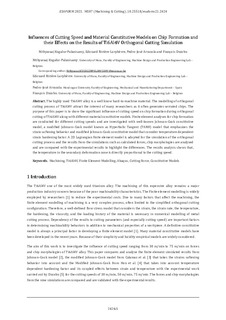Izenburua
Influences of Cutting Speed and Material Constitutive Models on Chip Formation and their Effects on the Results of Ti6Al4V Orthogonal Cutting SimulationEgilea
Egilea (beste erakunde batekoa)
Beste instituzio
Université de Mons (Bélgica)Bertsioa
Bertsio argitaratua
Eskubideak
© 2021 The authorsSarbidea
Sarbide irekiaArgitaratzailearen bertsioa
https://doi.org/10.25518/esaform21.2424Non argitaratua
ESAFORM Proceedings N. artículo, 2424, 2021Gako-hitzak
Machining
Ti6Al4V
Finite element modelling
Abaqus ... [+]
Ti6Al4V
Finite element modelling
Abaqus ... [+]
Machining
Ti6Al4V
Finite element modelling
Abaqus
Cutting forces
onstitutive Models [-]
Ti6Al4V
Finite element modelling
Abaqus
Cutting forces
onstitutive Models [-]
Laburpena
The highly used Ti6Al4V alloy is a well know hard-to-machine material. The modelling of orthogonal cutting process of Ti6Al4V attract the interest of many researchers as it often generates serrated ch ... [+]
The highly used Ti6Al4V alloy is a well know hard-to-machine material. The modelling of orthogonal cutting process of Ti6Al4V attract the interest of many researchers as it often generates serrated chips. The purpose of this paper is to show the significant influence of cutting speed on chip formation during orthogonal cutting of Ti6Al4V along with different material constitutive models. Finite element analyses for chip formation are conducted for different cutting speeds and are investigated with well-known Johnson-Cook constitutive model, a modified Johnson–Cook model known as Hyperbolic Tangent (TANH) model that emphasizes the strain softening behavior and modified Johnson-Cook constitutive model that consider temperature dependent strain hardening factor. A 2D Lagrangian finite element model is adopted for the simulation of the orthogonal cutting process and the results from the simulations such as calculated forces, chip morphologies are analyzed and are compared with the experimental results to highlight the differences. The results analysis shows that, the temperature in the secondary deformation zone is directly proportional to the cutting speed. [-]
Bildumak
Item honek honako baimen-fitxategi hauek dauzka asoziatuta:























